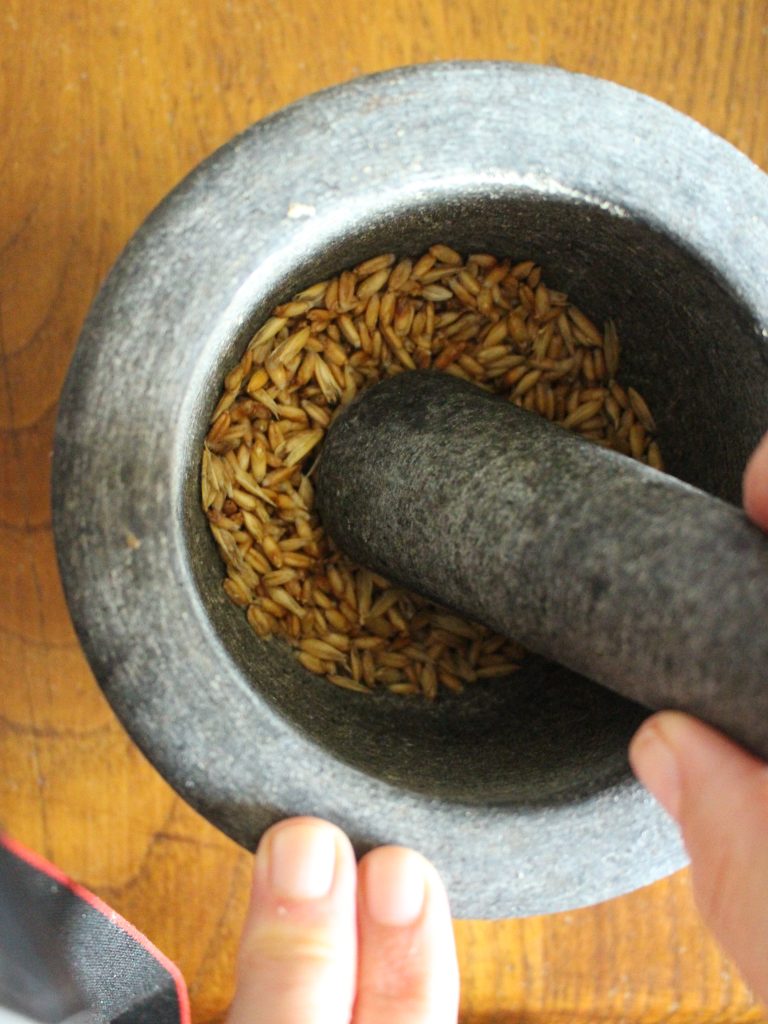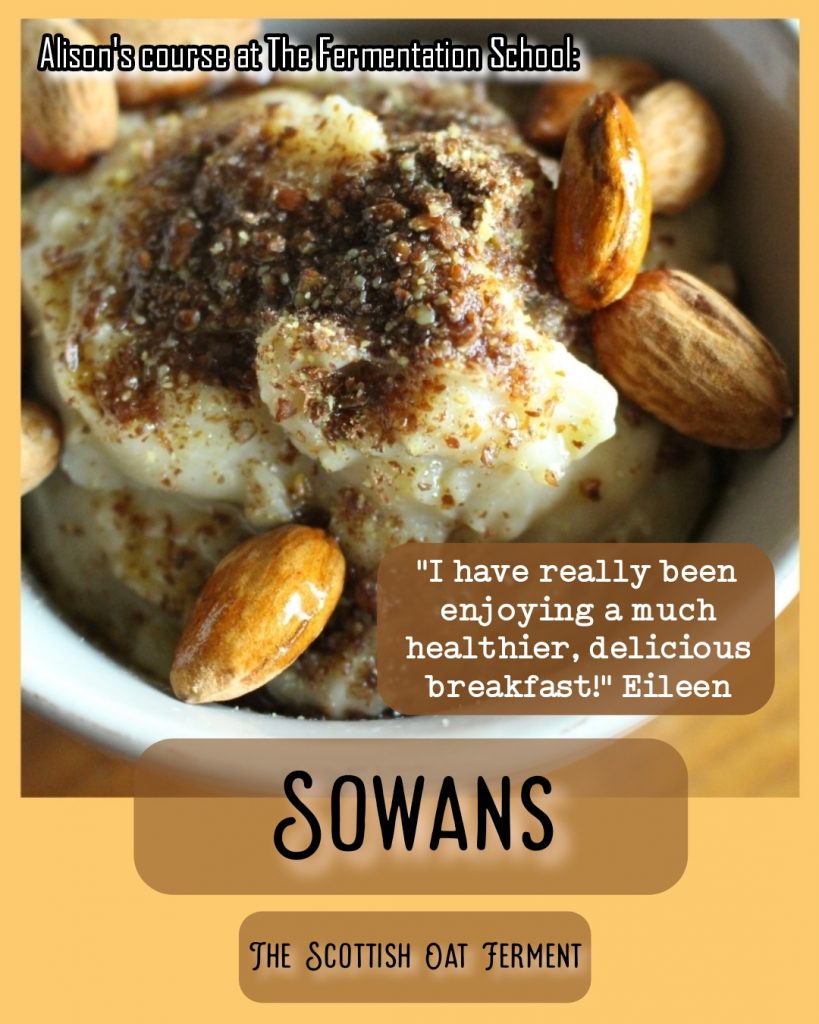Many of the cereals we see on breakfast tables these days are ridiculously-processed.
Ridiculously-processed is my term…‘extruded’ is the scientific term. Yes, some of the contents of the cereal packet may have started life as a grain but let me share with you what happens to that grain in just one of the leading oat-based breakfast cereals:
The oats are steam/heat-treated, ground into a paste with other ingredients (synthetic vitamins, sugar, salt and preservatives) and formed into pellets. These pellets are then loaded into a pressurised chamber. The pressure in this chamber is suddenly released, making the water vapour in the pellets expand which results in the the pellets puffing up in size.
Do we really need this to make our breakfast palatable?
Is this an example of how ‘advanced’ our society has become?
Today I want to tell you about a traditional Cornish oat breakfast: Pillas-gerts. Pillas-gerts was a type of gerty-milk; milk or water thickened with flour that was regularly eaten for breakfast. Pillas-gerts was a gerty-milk made with the locally-grown (quite often home-grown) variety of oat, pillas. And yes, it was processed; but good processed! Processed on a kitchen hearth with local materials to get the grain out of its husk and make it tastier.

I found out about gerty-milk, and the version made with pillas, from Harriet Gendall, a researcher who is currently doing a PhD on the ’small naked oat’ at the University of Kent and Royal Botanic Gardens, Kew. This oat was traditionally cultivated across various parts of Britain and Ireland under the name ‘pilcorn’, as well as in northern France, and in Cornwall where it was known as ‘pillas’. The last Cornish crop was reportedly harvested at Sancreed – near Land’s End – in 1867, while it continued in remote parts of West Ireland into the 1930s. Up until recently, when Harriet began her work, it has largely resided in seedbanks.
Oats are usually surrounded by a two-part husk which can be challenging to remove, but pillas is a ‘naked’ oat which means the husk surrounding the kernel is paper-thin and comes off more easily. Because of this, pillas became very popular in the UK and, as well as being an important chicken and pig feed, was also eaten – most notably in a thickened gerty-milk pudding called pillas-gerts.
Pillas-gerts (and gerty-milk) has fallen into history. No-one makes it any more. And Harriet has not yet been able to find anyone still alive who remembers how to make it. But there is a mention of it in a book called Stories and Folklore of West Cornwall written by William Bottrell in 1880. Harriet shared this with me and, of course, I immediately wanted to have a go at making it.
Making the ancestral Cornish pillas-gerts includes sprouting the ‘naked’ pillas oat grain. These days, standard oats cannot be sprouted (they’ve been heated to 100C to deactivate an enzyme in them that would cause them to otherwise go rancid). ‘Naked’ oat varieties, like pillas, have a paper-thin husk which is easier to remove. This means they don’t have to go through this treatment and can be spouted. I’ve not yet been able to get any pillas, the ancestral Cornish grain, but I do have access to another unprocessed ‘naked’ oat variety which is grown here in Italy by Silvia at Le Barbarighe.
Here’s how I tried to re-create pillas-gerts, a breakfast that was lost 200 years ago:
Stage 1 ‘Cheeney’ the oats.
The first step was to ‘cheeney’ the oats – which means to just sprout them. I soaked the oat groats for 24 hours and then left them to sprout for day.

Stage 2 – ‘Scroch’ the oats.
“Roastan of pillas es a very nice job, that but which few can be trusted to do; yet it’s worth all the labour.” Stories and Folklore of West Cornwall, Bottrell, 1880
Once the oats are showing signs of sprouting, they were transferred to a slow fire where, being stirred all the time, they were dried and ‘scroched’ a little – that is, burnt.

Stage 3 – Grind the oats.
“[She] put a handful or two at a time into as pretty a little moorstone traff (trough) as ever eyes ded see and pound’n till crushed fine enow.” Stories and Folklore of West Cornwall, Bottrell, 1880.
This is where, traditionally, a seashore pebble comes in. After roasting, the grains were cooled and then ground, a couple of handfuls at a time, in a stone trough using the local pebble. Not having a seashore pebble, I did this part in my stone mortar and pestle. My naked oats were completely unprocessed so this grinding detached the paper-like husk from the groat. I was left with a mixture of ground oats and whole husks. I sieved this mixture to remove the husks.

“You ought to see her beautiful little pillas-traff; et will only hold about a gallon; es as smooth as a basen inside and out; and es is so light that one can move ‘n about with ease.” Stories and Folklore of West Cornwall, Bottrell, 1880.
Stage 4 – Thicken milk with the fresh oat flour.
The fresh oat flour was then used to thicken milk which would have, traditionally, been unpasteurised. I used a local source of raw goat milk. There are no details available on the ratio of flour to milk so I guessed – using 10g of flour to 85ml of milk.
The result was a thick, creamy, toasty-flavoured, sweet, pudding-like mix that was delicious. The flavour of the freshly-roasted whole oats was incredible. I agree with Bottrell when he says,
“The change made in the grain, the better, wed’nt be believed or anyone not acquainted weth it” Stories and Folklore of West Cornwall, Bottrell, 1880
The creaminess of the milk complimented the toasty flavour very well and the sweetness of the milk also meant that the dish didn’t need further sweetening. It was a beautiful breakfast.
Pillas-gerts was a local, freshly-processed, hand-ground cereal. It would have been full of nutrients, actively connected eaters to the land that sustained them and also, as I now know, had a great flavour! The pelleted, fortified, exploded cereals sold by industrial giants whose products destroy our health are a poor comparison.
“They are too lazy now, and buy oatmeal from shops, or thicken their milk with barley flour; yet neither of them is half so good as the pillas-gerts that used to be grown by most everyone here who had a few acres of land.” Stories and Folklore of West Cornwall, Bottrell, 1880.
Pillas was also used for other foods, particularly baked puddings – that’s my next experiment!

Harriet is currently masterminding trials of pillas-growing in the UK. 2023 will be the first harvest with grain that can be eaten. You can hear her talking about the grain and her work in this presentation titled ‘The Journey for a Lost Oat’ hosted by the Sheffield Wheat Experiment.
If you love oats and would like to take an another historic British oat dish; one that involves fermentation, check out my video course Sowans: The Scottish Oat Ferment


Bring ancient grain baking into your kitchen!
Download my free 30-page guide with five healthy and tasty 100% ancient grains recipes.

